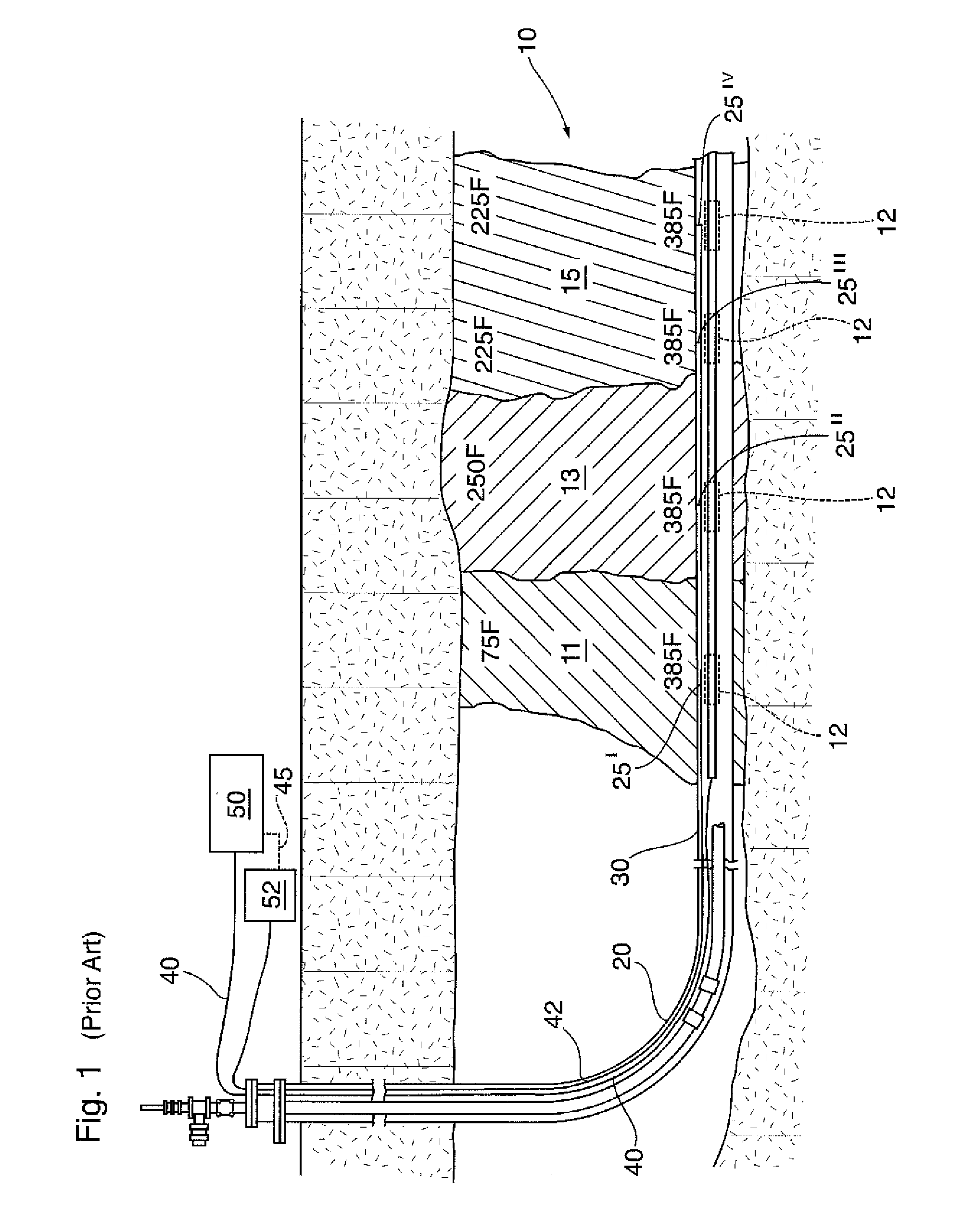Electrical heating method for a hydrocarbon formation, and improved thermal recovery method using electrical pre-heating method
a hydrocarbon and heating method technology, applied in the field of electric heating methods for hydrocarbon formations, to achieve the effect of improving the mobility of oil
- Summary
- Abstract
- Description
- Claims
- Application Information
AI Technical Summary
Benefits of technology
Problems solved by technology
Method used
Image
Examples
example 1
[0101]In order to confirm the positive impact of the method of the present invention, and in particular the more extensive temperature conformity throughout various regions of a non-homogenous formation for SAGD operations for which an electrical pre-heating step has been conducted, a sample formation was modelled, using the computer numerical simulation of the STARS™ Thermal Simulator 2010.12 provided by the Computer Modelling Group, Calgary, Alberta, Canada.
[0102]The modelling reservoir used in Examples 1 &2 herein contained bitumen at 7° C., with uniform porosity (30%), but comprising three (3) distinct and separate areas 11, 13, and 15 as shown in FIGS. 1-6 herein, such regions and formation 10 having properties as shown in Table 1 below, and in particular containing, as shown in Table 1 below, initial water saturation at the heel of 7% (i.e. region 11), mid-well initial water saturation of 22% (i.e. in region 13), and initial water saturation at the toe of 15% (i.e. in region 1...
example 2
[0110]The same formation was modelled with two similar wells 20, 70, but with electrical heating instead of steam circulation. Such electrical heating was carried out in accordance with the prior art methods of maintaining constant temperature along the wellbores.
[0111]In this regard, the same well pair 20 and 70 were used, with three electrical heating elements 12 inserted in each of wells 20 and 70 as shown in FIG. 6, for heating respectively the three distinct regions 11, 13, and 15.
[0112]FIG. 12 shows, with reference to the temperature correlation grid on the right hand side, the temperature distribution within the 3 regions of the modelled formation having electrical heating within both of wells 20, 70, after 1 month.
[0113]FIG. 13 shows, with reference to the temperature correlation grid on the right hand side, the temperature distribution within the 3 regions of the modelled formation having electrical heating of such 3 regions from both of wells 20, 70, after 2 months.
[0114]F...
example 3
[0116]In this example the same formation was modelled with two similar wells 20, 70, but with optimized electrical pre-heating of each of the three regions 11, 13, and 15 in accordance with the method of the present invention.
[0117]Specifically, electrical heating was carried out with a maximum target temperature of 400° C. in respect of region 11, a temperature of 50° C. in respect of region 13 (i.e. no heating), and a target temperature of 300° C. in respect of region 15.
[0118]FIG. 16 shows, with reference to the temperature correlation grid on the right hand side, the temperature distribution within the 3 regions 11, 13, and 15 of the modelled formation having such optimized electrical heating of such 3 regions within both of wells 20, 70, after 3 months.
[0119]FIG. 17 shows, with reference to the temperature correlation grid on the right hand side, the temperature distribution within the 3 regions of the modelled formation after three (3) months of optimized electrical pre-heatin...
PUM
 Login to View More
Login to View More Abstract
Description
Claims
Application Information
 Login to View More
Login to View More - R&D
- Intellectual Property
- Life Sciences
- Materials
- Tech Scout
- Unparalleled Data Quality
- Higher Quality Content
- 60% Fewer Hallucinations
Browse by: Latest US Patents, China's latest patents, Technical Efficacy Thesaurus, Application Domain, Technology Topic, Popular Technical Reports.
© 2025 PatSnap. All rights reserved.Legal|Privacy policy|Modern Slavery Act Transparency Statement|Sitemap|About US| Contact US: help@patsnap.com



